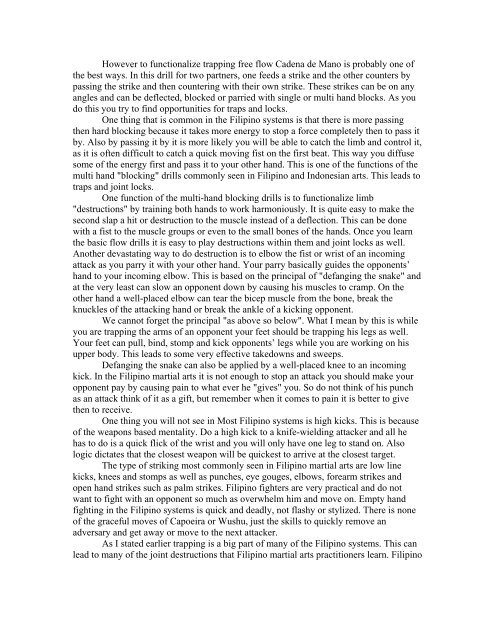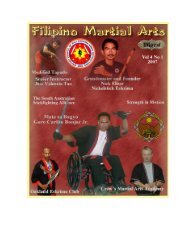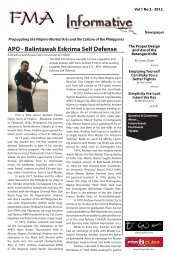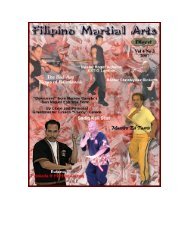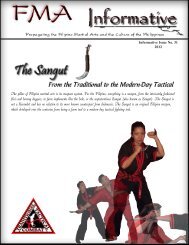Tournaments - FMA Informative
Tournaments - FMA Informative
Tournaments - FMA Informative
Create successful ePaper yourself
Turn your PDF publications into a flip-book with our unique Google optimized e-Paper software.
However to functionalize trapping free flow Cadena de Mano is probably one of<br />
the best ways. In this drill for two partners, one feeds a strike and the other counters by<br />
passing the strike and then countering with their own strike. These strikes can be on any<br />
angles and can be deflected, blocked or parried with single or multi hand blocks. As you<br />
do this you try to find opportunities for traps and locks.<br />
One thing that is common in the Filipino systems is that there is more passing<br />
then hard blocking because it takes more energy to stop a force completely then to pass it<br />
by. Also by passing it by it is more likely you will be able to catch the limb and control it,<br />
as it is often difficult to catch a quick moving fist on the first beat. This way you diffuse<br />
some of the energy first and pass it to your other hand. This is one of the functions of the<br />
multi hand "blocking" drills commonly seen in Filipino and Indonesian arts. This leads to<br />
traps and joint locks.<br />
One function of the multi-hand blocking drills is to functionalize limb<br />
"destructions" by training both hands to work harmoniously. It is quite easy to make the<br />
second slap a hit or destruction to the muscle instead of a deflection. This can be done<br />
with a fist to the muscle groups or even to the small bones of the hands. Once you learn<br />
the basic flow drills it is easy to play destructions within them and joint locks as well.<br />
Another devastating way to do destruction is to elbow the fist or wrist of an incoming<br />
attack as you parry it with your other hand. Your parry basically guides the opponents’<br />
hand to your incoming elbow. This is based on the principal of "defanging the snake" and<br />
at the very least can slow an opponent down by causing his muscles to cramp. On the<br />
other hand a well-placed elbow can tear the bicep muscle from the bone, break the<br />
knuckles of the attacking hand or break the ankle of a kicking opponent.<br />
We cannot forget the principal "as above so below". What I mean by this is while<br />
you are trapping the arms of an opponent your feet should be trapping his legs as well.<br />
Your feet can pull, bind, stomp and kick opponents’ legs while you are working on his<br />
upper body. This leads to some very effective takedowns and sweeps.<br />
Defanging the snake can also be applied by a well-placed knee to an incoming<br />
kick. In the Filipino martial arts it is not enough to stop an attack you should make your<br />
opponent pay by causing pain to what ever he "gives" you. So do not think of his punch<br />
as an attack think of it as a gift, but remember when it comes to pain it is better to give<br />
then to receive.<br />
One thing you will not see in Most Filipino systems is high kicks. This is because<br />
of the weapons based mentality. Do a high kick to a knife-wielding attacker and all he<br />
has to do is a quick flick of the wrist and you will only have one leg to stand on. Also<br />
logic dictates that the closest weapon will be quickest to arrive at the closest target.<br />
The type of striking most commonly seen in Filipino martial arts are low line<br />
kicks, knees and stomps as well as punches, eye gouges, elbows, forearm strikes and<br />
open hand strikes such as palm strikes. Filipino fighters are very practical and do not<br />
want to fight with an opponent so much as overwhelm him and move on. Empty hand<br />
fighting in the Filipino systems is quick and deadly, not flashy or stylized. There is none<br />
of the graceful moves of Capoeira or Wushu, just the skills to quickly remove an<br />
adversary and get away or move to the next attacker.<br />
As I stated earlier trapping is a big part of many of the Filipino systems. This can<br />
lead to many of the joint destructions that Filipino martial arts practitioners learn. Filipino


